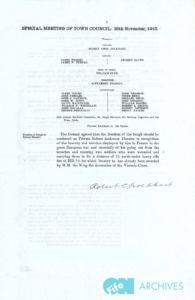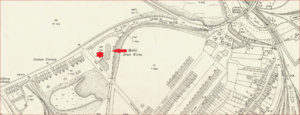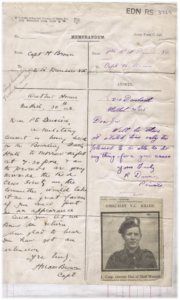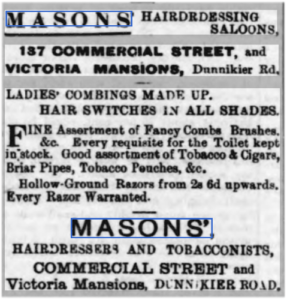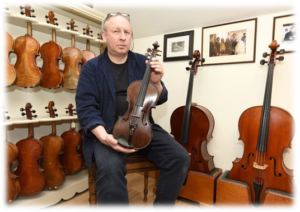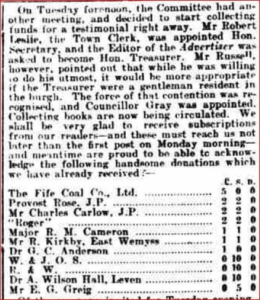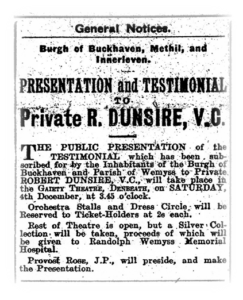29 November to 4 December 1915
The approaching days would have been momentous for any person or family. The activities and recognition must have brought honour and distinction beyond a young miner’s and or his family’s comprehension. Robert’s journey, during his 24 years, was remarkable but now it was dreamlike. Along the way, Robert’s every step and every act continued to be assured and purposeful.
Monday, 29 November 1915: Freedom of Kirkcaldy
A special meeting of the Royal Burgh of Kirkcaldy was convened on 29 November 1915, to confirm the Award of the Freedom of the Burgh to Private Robert Anderson Dunsire VC. Provost Lockhart was in the chair.
This minute of a Special Meeting of the Town Council of the Royal Burgh of Kirkcaldy met to confirm the Award of the Freedom of Kirkcaldy to Robert.
On the way to the ceremony that followed on the same evening of the Special Meeting of Kirkcaldy Town Council Robert learned that the appeal for an extension to his furlough had been successful and he would not be leaving for another week.
More information on the Award and Ceremony is in the Section – Home Awards.
Tuesday, 30 November 1915: Extended Leave
Before the intervention of Town Clerk Leslie, at the behest of Provost Rose of Buckhaven, Methil and Innerleven Council, Robert was supposed to be on his way back to France by Tuesday, 30 November and had attended the Burgess Ceremony fully kitted in case he had to go straight to the station for the overnight train.
The news of his extension meant that he now had a day free of events and an opportunity to reflect once more on the past week or so. He had been on a non-stop treadmill, but handled everything thrown at him with canny self-assurance and sure-footedness. Throughout Robert displayed a level of tact, diplomacy and awareness that was beyond anything he probably had needed before this. His speeches were to the point, relevant to the key messages of the day for a soldier who had experience of war, its needs and brutality, while being sensitive to his audience and his reasons for being there. When asked, he happily played his violin as part of the entertainment of the day – when did he have time to practise? He appeared unfazed by the presence of the local ‘great and the good’, but was always respectful and humble in their presence.
This was all reflected in local and national press coverage of Robert’s awards and his conduct at each and every event he attended. The pride of his whole family could only have grown over the week, as his comportment reflected well on how he had been raised, but also demonstrated the respect that the family had earned over many years in the local communities of Kirkcaldy and Buckhaven, Methil and Innerleven.
Wednesday, 1 December 1915: Methil Brickworks
Methil Brick Works was on the main tramway route from Aberhill Depot to Leven. Provost Donald Rose was the first Managing Director of the Methil Brick Company whose kiln had been first fired up in August 1908. As a child I have many memories of the mixing drum of the brickworks being fired up at night at the start of the nightshift. My grandparents, including my grandfather who was also in D Company of the 13th Battalion of the Royal Scots with Robert Dunsire VC, lived in the first houses at nearby Jordan Terrace.
Attr: NLS Map Fifeshire XXVIII (Markinch Scoonie Wemyss) Published 1914
Robert’s visit took place in the forenoon at the invitation of Provost Rose. After the familiar enthusiastic welcome, Robert received a pocket book on behalf of the female staff. He also received a supply of cigarettes, in cases specially made for use at the front, from the male staff.
In his speech about Robert’s brave act, Provost Rose prayed he would come back, if not an officer, then at least with as many stripes on his arm as it was possible to achieve. Robert’s response was in keeping with everything he had said on other such occasions. He had one extra duty to perform when he presented the female employees with a large parcel of chocolates before he left.
The journey was quick as the Wemyss Tramways Garage was only 300 or 400 yards along the road towards Denbeath and he was soon home again for some rest before his next event of the day. Robert had received the invitation to a military concert in the Bowling Green Hall in Methil and replied on Edinburgh Royal Scots memo paper. His reply was short and gracious: ‘Only too pleased to be able to do anything for a good cause’.
The event started at 19.30, to raise funds for the local Red Cross Society. It was a quiet evening for Robert, with no reports of his playing the violin or making speeches. Colonel Clarke of the Royal Scots made a special trip to Methil to meet him. Robert’s own Colonel Maclear had been wounded after Robert left for home.
Attr: Original Document held by the Museum of The Royal Scots
co-located with the Museum of the Royal Regiment of Scotland at Edinburgh Castle
The event started at 19.30, to raise funds for the local Red Cross Society. It was a quiet evening for Robert, with no reports of his playing the violin or making speeches. Colonel Clarke of the Royal Scots made a special trip to Methil to meet him. Robert’s own Colonel Maclear had been wounded after Robert left for home.
Thursday, 2 December 1915: Gift of violin and case
The pace slowed somewhat for Robert but he was soon heading back to his parents’ home in Pathhead. The day was more personal, with no plan for major public ceremonies and speeches. Newspapers had covered a story about Robert taking his 100-year-old violin with him to the trenches where he entertained his company colleagues when the opportunity arose. The violin had been sent home but had never arrived.
Robert was originally taught to play the violin by a local hairdressing saloon owner, Mr R. Mason. Mr Mason’s own violin dexterity and expertise was first highlighted when he was Leader of the Gallatown Musical Society at their first public concert in April 1902. During this concert he was praised for the fine tone of his playing a variety of solo pieces. He had premises in Victoria Mansions, where there is still a hairdresser today. His other premises were in Commercial Street near the home of Robert’s parents. It was to these premises that Robert headed on the afternoon of 2 December.
Attr: Fifeshire Advertiser - Saturday 19 December 1908
Newspaper image © The British Library Board. All rights reserved. The British Newspaper Archive (www.britishnewspaperarchive.co.uk).
That afternoon, Mr Mason handed over a splendid violin in a leather lock-up case, to replace his vintage violin that had gone missing in transit. The violin had been made by Mr Peter Berry of Rosabelle Street, Kirkcaldy, whose skills were greatly appreciated by Fife-based violinists such as Mr Honeyman from Newport. William C. Honeyman ran concert parties and was regarded as a great violin authority. His love of the violin is best given away by his address of Cremona Villa, Newport, and he was also known as a novelist of a series of detective stories, written under a pseudonym.
Peter Berry started up business as a joiner and contractor from his work base at Park Road in Sinclairtown, Kirkcaldy. He earned a reputation for generosity to soldiers – it was reported that he had already, through The Fifeshire Advertiser, presented a violin and case, a melodeon and gramophone records to soldiers at the front. Robert’s new violin had been made by Peter Berry as a gift.
Robert had limited opportunity to play this violin before he made his way back to France. However, the story of this violin gained fresh publicity when it was given to Mr David Rattray of Kirkcaldy – a maker and restorer of stringed instruments from the violin family – by renowned Scottish-Borders-born violinist Tony Moffat, whose CV features an impressive list of playing and leadership roles. Tony Moffat discovered the violin in a second-hand shop in Dundee and offered the violin to David without knowing the instrument’s provenance. David Rattray has a broad range of well-known clients and interesting roles attached to his CV (see www.davidrattrayviolins.co.uk).
Attr: David Rattray holds Robert's Beautifully Restored Violin at his workshop
For the violin to arrive back in Kirkcaldy and be restored was a lovely story. David explained that the maker’s name is impossible to miss as it is engraved below the button. The violin was played at an event on 3 March 2019 in Kirkcaldy Galleries, where Vince Gray, of the Kirkcaldy Orchestral Society, demonstrated the musical aspects of the violin and played music from the time of its gifting to Robert Dunsire VC.
Friday, 3 December 1915: Buckhaven
Robert must have already been thinking about his return to France, but he still had a date in London, at Buckingham Palace, where he would receive his Victoria Cross medal.
On 3 December, it was reported that Robert attended the Picture Theatre in Buckhaven. However, it is not clear if Robert was at the Picture House in the Gardener’s Hall that had opened up in May 1902, under the stewardship of an experienced cinema manager, Mr J.D. Forsyth. The other possibility was that Robert was at the new Globe Electric Theatre that had been recently completed and opened in 1915. There is no clue in any newspaper reports, most likely because of the build-up to a major event at the Gaiety Theatre, at Denbeath, the next day. This visit was not well publicised. I am sure Robert would have been relieved about that.
Saturday, 4 December 1915: Final Civic Reception at Denbeath
Saturday, 4 December marked Robert’s last recognition event before he headed to London and then France. It had been long in the planning. At a meeting of Buckhaven, Methil and Innerleven Council on Monday, 22 November, Provost Rose and his colleagues determined that every honour should be paid to the gallant young townsman. A committee that included Provost Rose, Baillie Taylor and Baillie Galloway, Mr J. Farmer, Mr A.H. Gillespie and Mr T. Gray was appointed to arrange a civic reception and testimonial. The reception took place the next day on 23 November 1915 at the White Swan Hotel. The testimonial was longer in the making, but fundraising was soon under way with Councillor Gray acting as Treasurer. The donations in guineas appear with a value at £1 1s. (£114 today). They were off to an excellent start as is demonstrated in reports from the Leven Advertiser and Wemyss Gazette of Thursday, 25 November, 1915.
Attr: Leven Advertiser & Wemyss Gazette - Thursday 25 November 1915
Newspaper image © The British Library Board. All rights reserved.
With thanks to The British Newspaper Archive (www.britishnewspaperarchive.co.uk).
By the time the testimonial committee had met again one week later over £70 had been collected. the editor of the Leven Advertiser had received £26 13s that included a very generous £10 10s from the Wemyss Coal Company.
The committee had already resolved on the location and content of the presentations to be made to Robert and Kate at the testimonial: Robert with a gold watch and chain; Kate with a gold brooch; with the balance to be War Loan Stock. Showing no favouritism, the names of the various jewellers in the burgh were put in a hat. The Burgh Treasurer made the draw and the chosen supplier was Mr William Greig of Methil.
Attr: Leven Advertiser & Wemyss Gazette - Thursday 2 December 1915
Newspaper image © The British Library Board. All rights reserved.
With thanks to The British Newspaper Archive (www.britishnewspaperarchive.co.uk).
The Gaiety Theatre was placed at their disposal by the manager, Mr Burnett. It was the most suitable location in the burgh by far. Provost Rose presided over proceedings and made the presentation, and there was a brief musical programme. There was no admission charge as it was a public function, but a collection was taken for the local, Denbeath-based Wemyss Memorial Hospital. By the day of the testimonial arrived more than 2,000 people had contributed. This only re-emphasised the impact that Robert’s award for his act of valour had on the local population and business owners.
More information on the Ceremony can be found at Home Awards.
